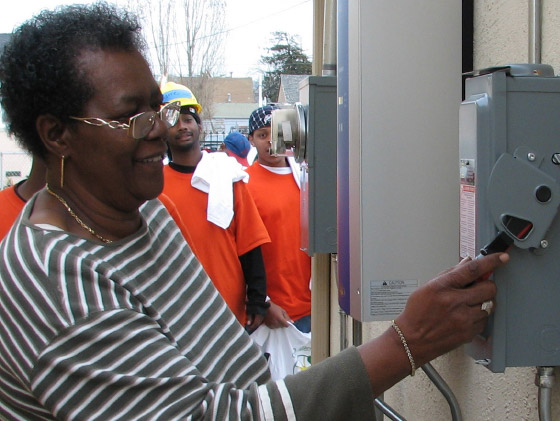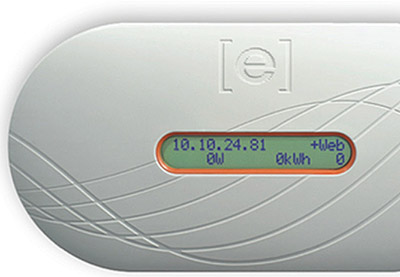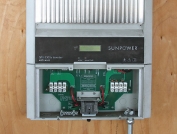How do I turn on my system?
How do I reboot my system?
What do I do if my system stops working?
How do I read my inverter?
What do I do if my inverter shows an error message?
I have microinverters. What do I do if my inverter is not working?
What should I be doing to maintain my system?
Why did my electric bill go up?
What do I do if pigeons are dirtying my panels?
SOLAR SYSTEM TECHNOLOGY
How do I turn on my system?
Make sure to turn on your system during the day when the sun is out.
- Step 1: Switch ON the breaker on your main electrical service panel. The breaker will be labeled with a solar sticker. Make sure breaker is fully on and you hear a “click.”
- Step 2: Switch ON the AC Disconnect. The lever should be flipped up to turn on the AC Disconnect.

If you have a string inverter, turn the inverter on:
- Step 3: Wait 15 minutes, then check your electricity meter. When the arrow is pointing to the left your solar system is producing power.

By Dwight Burdette CC BY 3.0, via Wikimedia Commons
Or, if you have a system with microinverters*:
- Step 3: Wait 15 minutes, then check the envoy monitor. Your envoy monitor should be connected to your Internet router. You might need to install a dedicated outlet depending on reception. If you do not see the correct number of panels displayed on your envoy, wait 24 hours. If after 2 days you still do not see the correct number to panels displayed on your envoy, call your GRID Alternatives Outreach Coordinator. Download our Inverter Display Messages Tip Sheet to learn more about how to read your device.

How do I reboot my system?
- Switch off the AC Disconnect by flipping the lever down.
- Switch off the breaker on main service panel. The Solar Contractor should have labeled the correct breaker with solar sticker. The direction you switch the breaker depends on your specific solar breaker. Make sure breaker is fully off and you hear a “click.”
- Your system should now be off. Wait 15 minutes before turning your system back on.
What do I do if my system stops working?
CAUTION: Even when one or more system switches is OFF, there might still be high voltage electricity in the system. Never try to service any part of the system including the wiring, fuses or breakers.
If your system is installed on your house, and interconnected with your utility, first try to reboot/reset your system as described above.
If your system is still not working, contact GRID Alternatives.
How do I read my inverter**?
Your inverter has indicator lights to help you check that the system is working. A green light displayed during daylight means that your system is working normally. Check for the green light at least once a week. This will help you catch any problems with your system before your electric bill is affected.
It’s a good idea to check the inverter more often in the summer when your system will be producing the most electricity.
NOTE: Review the owner’s manual your inverter came with for information about reading your specific display.

Common messages on your inverter screen:
- Inverter Offline - This is normal at night when the system is not generating electricity.
- Insufficient Solar Energy - This is normal when there is not enough sunlight for the system to produce electricity.
- Ground Fault - If you see this message, contact GRID Alternatives.
Systems with microinverters do not have indicator lights. Instead, they have a monitoring device called an envoy that shows the power being produced by each microinverter. Ensure that all the microinverters installed are shown on the device.
Download our Inverter Display Messages Tip Sheet to learn more about how to read your device.
What do I do if my inverter shows an error message?
If your inverted indicator light is red or yellow there is a system error. Write down the error message on the display screen and contact GRID Alternatives.
I have microinverters, what do I do if my inverter is not working?
First, try plugging the envoy into a different outlet. If there is no outlet in the house where the envoy works, contact GRID Alternatives.
What should I be doing to maintain my system?
Clean your panels
We recommend that you wash your solar panels at least once a year. If you live in a dusty area (for example, near a freeway or a construction site) it may help to wash the panels more often, especially before summer when the system produces the most electricity. To clean your panels, hose them down with water while standing on the ground. DO NOT GO UP ONTO YOUR ROOF. You can use a hose nozzle to help increase water pressure.
CAUTION: Do not wash your panels on a hot day. This may damage the panels. Washing your solar panels will make your roof wet and slippery. Never go onto the roof to clean your panels. Hose the panels from the ground. Never walk on the panels as this can damage them.
Reduce shading
Be sure to trim trees, plants or shrubs around your home that may shade any part of your solar panels. If you are installing an antenna or satellite dish, make sure it does not shade any part of your solar panels because this can lower the system’s electricity production. Also watch for shade that may be caused by new buildings or new trees near your home.
Why did my electric bill go up?
The solar system was designed based on your last year’s energy usage. It’s possible that you are using more energy now than you were then. Did you add new electronics or appliances? Think about your energy habits, and consult our energy efficiency guide. Remember, the solar system will produce more electricity in the summer months compared to winter months.
*A solar micro-inverter, or simply microinverter, is a device used in photovoltaics that converts direct current (DC) generated by a single solar module to alternating current (AC). The output from several microinverters is combined and often fed to the electrical grid. Microinverters contrast with conventional string and central solar inverters, which are connected to multiple solar modules or panels of the PV system.
**An inverter, is an electronic device or circuitry that changes direct current (DC) to alternating current (AC).
What do I do if pigeons are dirtying my panels?
If you discover that pigeons or other wildlife have dirtied your panels, please contact GRID Alternatives and we will arrange for professional cleanup. Bird waste can be a health hazard, so please do not try to clean the panels yourself.
